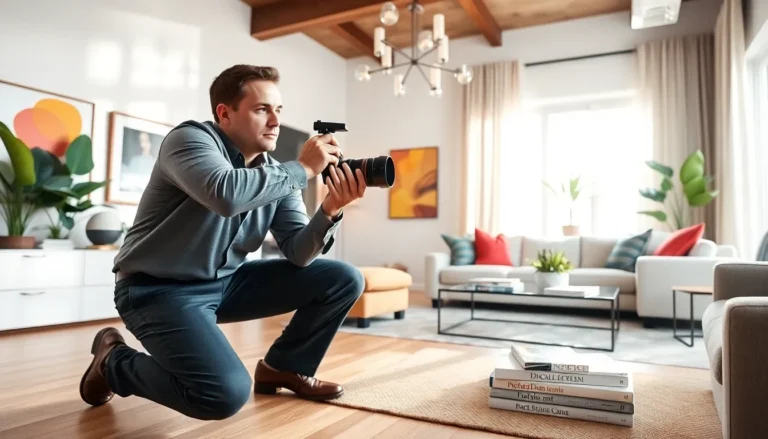Creating design and decor might sound daunting, but let’s face it, it’s like assembling a massive jigsaw puzzle without the box. Sure, it can be overwhelming, but it can also be a hilariously fun adventure, like trying to make IKEA furniture without the instruction manual, only to find out you put a piece upside down. This guide breaks down the essential elements of design and decor, helping you transform any space into something spectacular. Whether you’re channeling your inner interior designer or just looking to spruce up a room, buckle up to discover the realm of color palettes, textures, and styles in a way that’s entertaining and informative.
Table of Contents
ToggleUnderstanding Design Principles

To create effective design and decor, one must first grasp the crucial design principles. It’s much like knowing the rules of a game before you jump into play.
Elements Of Design
The elements of design are the building blocks of any space. These include:
- Line: Lines can direct the eye and create feelings of movement. Think of them as the roads that guide you through your room.
- Shape: Shapes are two-dimensional and help define the room’s structure. Whether geometric or organic, they impact the space’s flow.
- Color: Color isn’t just about aesthetic appeal: it can evoke emotions and set moods. It’s like the mood ring of your space.
- Texture: Adding depth and interest to a room, textures can make surfaces tactile.
- Space: This refers to the area around the elements. Both positive and negative spaces are equally important: one must breathe.
- Form: Unlike shape, form is three-dimensional and can add physical volume to design.
Principles Of Design
Once the elements are understood, grasping the principles will elevate designs to the next level:
- Balance: This refers to the distribution of weight in a room. Achieving balance can be symmetrical, asymmetrical, or radial, think of it as how your laugh seems high-pitched after a particularly funny joke.
- Contrast: This principle highlights differences between colors, shapes, or textures. High contrast draws the eye and keeps the viewer engaged.
- Emphasis: Every room should have a focal point, something that captures attention right away. It could be a piece of art or a beautiful fireplace.
- Unity: Even though all the elements and principles, the design should feel like a cohesive whole. Unity ties everything together, just like the punchline of a good joke.
Finding Your Style
Designing a space without knowing your style is akin to cooking a gourmet meal without a recipe. So, how does one find their design identity?
Popular Design Styles
Many styles await exploration:
- Modern: Characterized by clean lines and minimalism, it feels fresh and uncluttered.
- Bohemian: A whimsical and artistic style featuring rich patterns and textures. Toss in some plants, and you’re set.
- Industrial: Raw materials and an urban vibe define this style, perfect for those who appreciate the beauty in exposed brick.
- Scandinavian: This is about simplicity and functionality, emphasizing light, muted colors and natural materials.
- Rustic: A warm and cozy feely style that incorporates natural elements and vintage pieces.
Creating A Mood Board
A mood board is like a love letter to your ideas. Begin by gathering images, fabric swatches, and color samples that resonate with your style. This visual representation helps keep your vision clear and guides decisions as you move forward.
Choosing The Right Color Palette
Color can make or break a space, so it’s wise to choose wisely.
Color Theory Basics
Understanding color theory is essential. Colors are generally classified into:
- Warm colors: Such as red, orange, and yellow, these evoke energy and excitement. Perfect for social spaces.
- Cool colors: Blue, green, and purple promote calm and relaxation, making them great for bedrooms.
- Neutral colors: Whites, grays, and browns provide balance and can serve as a perfect backdrop.
Color Combinations To Consider
While experimenting is encouraged, sticking to a few classic combinations can yield great results:
- Monochromatic: Variants of the same color create a modern and sophisticated look.
- Analogous: Colors next to each other on the color wheel often yield a serene and comfortable palette.
- Complementary: Opposite colors can create energy and vibrancy, adding life to the room.
Incorporating Textures And Patterns
Textures and patterns can breathe life into your design. Adding variety makes a space visually stimulating and personalized.
Creating Visual Interest
Mixing different fabrics, such as velvet, linen, and leather, can create a layered look, much like a decadent dessert with multiple flavors. Adding textures can foster comfort, warmth, or even elegance, depending on the desired effect.
Balancing Textures In Your Space
Be careful. Too many textures can overwhelm a room. The goal should be a harmonious blend. Consider the main texture for a focal point, while coupling it with a couple of complementary textures to create balance.
Selecting Furniture And Decor Items
Choosing the right furniture and decor is like assembling a curated collection of your personality.
Focal Points In Design
Identify your room’s focal point first. Be it a striking sofa or an eye-catching piece of artwork, it sets the tone for everything else in the room.
Accessorizing Your Space
Accessorizing is where the fun begins. Use throw pillows, artwork, or even unique knick-knacks that resonate with your personal story. Each accessory should echo your chosen style and color palette, resulting in a well-informed and cohesive look.
Implementing Your Design Plan
With all the planning done, it’s finally time to bring your vision to life.
Step-By-Step Implementation
Start by clearing the space and measuring everything thoroughly. This is the moment to manifest all those dreamy ideas. Work logically, from larger pieces to smaller accessories. Don’t hesitate to adjust. Design is often iterative.
Final Touches And Adjustments
Once everything is in place, take a step back. Observe the space and see if it feels right. Sometimes, all it takes is a minor shift of a piece or the addition of a well-placed plant to complete the look.



